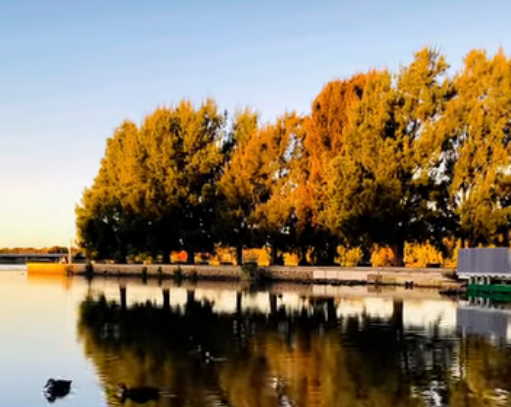
When Miranda took her beloved kelpie Scout to Lake Ginninderra's dog beach on a warm September afternoon, she expected nothing more than an hour of her energetic companion's favourite activity.
Within five minutes of leaving the water, Scout was struggling to walk. Within an hour, he was gone.
Scout's tragic death on September 29, allegedly from blue-green algae poisoning, has joined a growing number of cases that have veterinarians across Canberra raising urgent warnings about the invisible killer in our waterways.
What exactly is blue-green algae?
Despite its name, blue-green algae isn't algae at all—it's actually a toxic type of bacteria called cyanobacteria that lives in algae.
These microscopic organisms are commonly found in fresh lakes, ponds and other sources of non-flowing water, but can also thrive in birdbaths, garden pots and anywhere water becomes stagnant.
Recent EPA testing at Lake Ginninderra found the presence of Tychonema sp at medium levels, a naturally occurring species that becomes dangerous when it multiplies rapidly under the right conditions.
'It was so fast. When I got into the driver's seat and I looked back at him, his eyes were just sunken in and he looked like he was trying to tell me something was very wrong'
The critical window: Recognising the symptoms
Blue-green algae poisoning manifests rapidly in dogs, typically within 15 minutes to several hours after exposure. Signs often occur within 20-30 minutes of drinking contaminated water.
The progression can be terrifyingly swift. Scout's experience mirrors what veterinarians describe as the typical pattern: initial wobbliness and weakness, followed rapidly by more severe symptoms.
Watch for these warning signs within 30 minutes of water contact
- Stumbling or difficulty walking
- Vomiting and drooling
- Sunken eyes or vacant expression
- Difficulty breathing
- Seizures in severe cases
- Sudden collapse
Dr Eamon Ryan, the Canberra veterinarian who treated Scout, explained that the condition is 'an acute, often fatal condition caused by high concentrations of toxic blue-green algae.'
Some types can cause symptoms or become fatal just 15 minutes to an hour after a dog drinks contaminated water.
Treatment realities: Intensive care and tough decisions
There is currently no known antidote for the toxins, so prompt veterinary treatment is essential to tackle their effects and ensure a good chance of recovery.
The treatment Scout received represents the standard intensive care protocol: intravenous fluids and plasma, muscle relaxants to assist with muscle tremors, and anti-seizure drugs. Intensive care may include a fluid drip, medicines, close monitoring and blood tests.
Megan Wright from Canberra Veterinary Emergency Services reported treating three dogs for blue-green algae toxicity since June, including one as recently as Monday night that required four hours of critical care and ventilation. Importantly, that dog survived and went home.
Treatment costs and reality
Emergency treatment for blue-green algae poisoning can cost several thousand dollars and may involve days of intensive care. However, recovery is possible, but may take weeks or months. Success depends critically on how quickly treatment begins after exposure.
The hidden danger: It's not just about drinking the water
Here's something many dog owners don't realise: dogs can ingest very high concentrations of organisms from grooming their coat after contact with contaminated water.
Particular care should be taken with dogs as they can ingest high concentrations of organisms from grooming their coat—meaning your dog doesn't have to drink lake water to be poisoned. Simply swimming or wading can be enough if they later lick their fur clean.
If your dog comes in contact with blue-green algae, rinse them off immediately with clean water and call your veterinarian immediately.
The current situation: Lake Ginninderra and beyond
While recent EPA testing found low levels of both blue-green algae and Tychonema sp in Lake Ginninderra, the veterinary evidence tells a different story. All three dogs treated at Canberra Veterinary Emergency Services had been at Lake Ginninderra.
Dr Rod Ubrihien from the University of Canberra explains the challenge: blue-green algae floats in upper water columns, meaning wind can push it around and into concentrated spots.
Testing from boats in the middle of the lake might miss dangerous concentrations along the shoreline where dogs play.
'Usually, we think of Lake Ginninderra as the best in terms of blue-green algae among Canberra's three main lakes. It is very early in the season to have blooms... But, again, nature's unpredictable.'
A growing Australian problem
Lake Ginninderra isn't alone in facing algal bloom challenges. In March 2025, a marine heatwave-induced bloom killed thousands of marine creatures along South Australia's Fleurieu Peninsula, while marine ecologists warn that ocean warming and marine heatwaves associated with climate change are leading to increased algal blooms.
Blue-green algae toxicity is more common in the warmer months, particularly towards the end of summer, but Scout's case in late September shows the season is extending.
Did you know?
Did you know?
High water temperatures due to climate change allow cyanobacteria to multiply rapidly, while winds that push algae towards shores contribute to dangerous concentrations. This combination means our pets face increasing risks as Australia's climate continues to warm.
Protecting your four-legged family
Prevention remains the best strategy, but it requires more than just avoiding obviously green water. Not all algae is poisonous, yet it's difficult to tell toxic algae apart from non-toxic algae.
Miranda has called for better accessibility to water quality information, suggesting QR codes be placed lakeside for easy smartphone access to current conditions.
Currently, the ACT government provides water quality advice online and through the Canadian Swim Guide app, which covers over 8,000 waterways globally.
Better warnings needed
Dog advocacy groups argue it's unacceptable that local lakes continue to be listed as 'open' when they're known to contain toxic algae, with no clear warnings provided to dog owners.
Dr Su Wild-River from the Environment Protection Authority acknowledges the challenge: 'It's important to understand that blue-green algae is natural and always going to be present in ACT lakes and waterways. What's of concern is if it gets elevated.'
The recent installation of a new wetland at Belconnen Oval aims to reduce pollution runoff into Lake Ginninderra, potentially decreasing future bloom likelihood—but for Scout and Miranda, that innovation comes too late.
Moving forward: Technology and transparency
Miranda's suggestion for QR code access to real-time water quality data reflects a broader need for more accessible, immediate information.
While the current system requires owners to remember to check websites or apps, QR codes could provide instant, location-specific updates right where decisions are made.
The technology exists, and the need is clear—particularly as reports of dogs suffering from toxic exposure after playing in algae-infested ponds and lakes are increasing.
For now, the advice remains simple but vital: when in doubt, keep your dog out. Avoid drinking from or walking and swimming in water that has visible algal blooms, scum, foam on the surface or that has an odour.
What This Means For You
Scout's story serves as both a heartbreaking warning and a call to action. In Miranda's words, he was 'a very special boy' who loved to explore. Ensuring other dogs can continue exploring safely will be his lasting legacy.
What's your experience with water quality warnings at local lakes and rivers? Have you noticed changes in algae levels at your favourite dog swimming spots? Share your thoughts and help keep our community's pets safe.
Primary Source
https://www.abc.net.au/news/2025-10...gae-lake-ginninderra-toxic-dog-dead/105865256
Dog allegedly dies from blue-green algae at Lake Ginninderra | Braidwood Times | Braidwood, NSW
Cited text: Miranda Lahde, the 35-year-old pet parent from Florey, lost her three-year-old dog Scout following a suspected blue-green algae poisoning after the ke...
Excerpt: Scout's tragic death on September 29, allegedly from blue-green algae poisoning, has joined a growing number of cases that have veterinarians across Canberra raising urgent warnings about the invisible killer in our waterways.
https://www.braidwoodtimes.com.au/s...es-from-blue-green-algae-at-lake-ginninderra/
Dog allegedly dies from blue-green algae at Lake Ginninderra | Braidwood Times | Braidwood, NSW
Cited text: The dog died within hours, allegedly due to blue-green algae poisoning from the lake water where he was playing.
Excerpt: Scout's tragic death on September 29, allegedly from blue-green algae poisoning, has joined a growing number of cases that have veterinarians across Canberra raising urgent warnings about the invisible killer in our waterways.
https://www.braidwoodtimes.com.au/s...es-from-blue-green-algae-at-lake-ginninderra/
How To Identify Toxic Blue-Green Algae: Keeping Your Dog Safe | PetMD
Cited text: The term “blue-green algae” generally refers not to a type of algae, but rather to a toxic type of bacteria that lives in algae, called cyanobacteria.
Excerpt: blue-green algae isn't algae at all—it's actually a toxic type of bacteria called cyanobacteria that lives in algae.
https://www.petmd.com/dog/poisoning/how-to-identify-blue-green-algae-for-dogs
Warning: Blue-green algae toxicity a danger to dogs—PetProfessional
Cited text: Blue-green algae are commonly found in fresh lakes, ponds and other sources of non-flowing water. However, this microscopic bacteria can also live in ...
Excerpt: These microscopic organisms are commonly found in fresh lakes, ponds and other sources of non-flowing water, but can also thrive in birdbaths, garden pots and anywhere water becomes stagnant.
https://www.petprofessional.com.au/info-centre/blue-green-algae-toxicity-dogs/
Warning signs installed after dog dies from ingesting blue-green algae in Lake Ginninderra | Region Canberra
Cited text: “The inspection indicated the presence of Tychonema sp at medium levels.” · READ ALSO ACT Govt urged to ‘reduce endless merry-go-round’ of alleged bai...
Excerpt: Recent EPA testing at Lake Ginninderra found the presence of Tychonema sp at medium levels
https://region.com.au/dog-dies-afte...ng-at-a-dog-beach-at-lake-ginninderra/910703/
Algae Alert: Understanding the Dangers of Blue-Green Algae for Pets—AAHA
Cited text: Blue-green algae poisoning, also known as cyanobacterial toxicosis, manifests rapidly in dogs, typically 15 minutes to several hours after exposure.
Excerpt: Blue-green algae poisoning manifests rapidly in dogs, typically within 15 minutes to several hours after exposure.
https://www.aaha.org/resources/algae-alert-understanding-the-dangers-of-blue-green-algae-for-pets/
Blue-Green algae—what are the risks for your pets? | Direct Vet Services
Cited text: Signs will often occur within 20-30 minutes of the dog drinking the contaminated water.
Excerpt: Signs often occur within 20-30 minutes of drinking contaminated water.
https://directvetservices.com.au/2022/12/01/blue-green-algae-what-are-the-risks-for-your-pets/
Warning: Blue-green algae toxicity a danger to dogs—PetProfessional
Cited text: According to the Veterinary Manual, algae toxicity ‘is an acute, often fatal condition caused by high concentrations of toxic blue-green algae (more c...
Excerpt: the condition is 'an acute, often fatal condition caused by high concentrations of toxic blue-green algae.'
https://www.petprofessional.com.au/info-centre/blue-green-algae-toxicity-dogs/
Blue-Green Algae and its Dangers to Dogs | Blue Cross
Cited text: Some types of blue-green algae can cause symptoms, or become fatal, just 15 minutes to an hour after a dog drinks contaminated water.
Excerpt: Some types can cause symptoms or become fatal just 15 minutes to an hour after a dog drinks contaminated water.
https://www.bluecross.org.uk/advice/dog/blue-green-algae-and-its-dangers-to-dogs
Blue Green Algae and Dogs—The Dangers | Vetsure
Cited text: “There is currently no known antidote for the toxins, so prompt veterinary treatment is essential to tackle their effects and ensure a good chance of ...
Excerpt: There is currently no known antidote for the toxins, so prompt veterinary treatment is essential to tackle their effects and ensure a good chance of recovery.
https://www.vetsure.com/blue-green-algae-and-dogs-the-dangers/
Warning: Blue-green algae toxicity a danger to dogs—PetProfessional
Cited text: Treatment options might include intravenous fluids and plasma, muscle relaxants to assist with muscle tremors and anti-seizure drugs.
Excerpt: intravenous fluids and plasma, muscle relaxants to assist with muscle tremors, and anti-seizure drugs.
https://www.petprofessional.com.au/info-centre/blue-green-algae-toxicity-dogs/
Blue Green Algae Poisoning in Dogs—PDSA
Cited text: Intensive care—if your dog has already developed symptoms of poisoning, they are likely to need intensive care, which may include a fluid drip, medi...
Excerpt: Intensive care may include a fluid drip, medicines, close monitoring and blood tests.
https://www.pdsa.org.uk/pet-help-an...conditions/blue-green-algae-poisoning-in-dogs
Warning signs installed after dog dies from ingesting blue-green algae in Lake Ginninderra | Region Canberra
Cited text: The latest EPA investigation (from 8 October) found low levels of both blue-green algae and Tychonema sp were present in the lake.
Excerpt: Megan Wright from Canberra Veterinary Emergency Services reported treating three dogs for blue-green algae toxicity since June, including one as recently as Monday night that required four hours of critical care and ventilation.
https://region.com.au/dog-dies-afte...ng-at-a-dog-beach-at-lake-ginninderra/910703/
Cyanobacteria in Dogs—Symptoms, Causes, Diagnosis, Treatment, Recovery, Management, Cost
Cited text: Recovery is possible, but may take weeks or months.
Excerpt: recovery is possible, but may take weeks or months.
https://wagwalking.com/condition/cyanobacteria
Blue green algae | SA Health
Cited text: restrict pet and livestock access to any water supply containing or suspected of containing blue green algae · do not let animals bathe in or drink co...
Excerpt: dogs can ingest very high concentrations of organisms from grooming their coat after contact with contaminated water.
https://www.sahealth.sa.gov.au/wps/...ter+quality/blue+green+algae/blue+green+algae
Blue-Green Algae Poisoning in Dogs: Symptoms and Prevention
Cited text: Rinse your dog off immediately with clean water if they come in contact with blue-green algae. Call your veterinarian immediately.If you feel your pet...
Excerpt: If your dog comes in contact with blue-green algae, rinse them off immediately with clean water and call your veterinarian immediately.
https://www.akc.org/expert-advice/news/blue-green-algae-symptoms-tips/
Warning signs installed after dog dies from ingesting blue-green algae in Lake Ginninderra | Region Canberra
Cited text: Water samples are also being analysed to confirm the specific algae species present, with the alert to be in force until the results are in.
Excerpt: All three dogs treated at Canberra Veterinary Emergency Services had been at Lake Ginninderra.
https://region.com.au/dog-dies-afte...ng-at-a-dog-beach-at-lake-ginninderra/910703/
Water Quality | National Capital Authority
Cited text: Event organisers should ensure that participants are aware of the blue-green algae alert level, associated exposure risks and provide adequate showeri...
Excerpt: blue-green algae floats in upper water columns, meaning wind can push it around and into concentrated spots.
https://www.nca.gov.au/environment/lake-burley-griffin/water-quality
Water Quality | National Capital Authority
Cited text: This area has high levels of blue green algae and is CLOSED to Primary Contact Recreation.
Excerpt: 'Usually, we think of Lake Ginninderra as the best in terms of blue-green algae among Canberra's three main lakes.
https://www.nca.gov.au/environment/lake-burley-griffin/water-quality
2025 algal bloom in South Australia—Wikipedia
Cited text: In March 2025, a marine heatwave-induced bloom of Karenia mikimotoi was blamed for the deaths of thousands of marine creatures, as well as coughing, s...
Excerpt: In March 2025, a marine heatwave-induced bloom killed thousands of marine creatures along South Australia's Fleurieu Peninsula
https://en.wikipedia.org/wiki/2025_algal_bloom_in_South_Australia
2025 algal bloom in South Australia—Wikipedia
Cited text: A marine heatwave that has occurred since September 2024, raising water temperatures by about 2.5C · According to the not-for-profit Biodiversity Coun...
Excerpt: marine ecologists warn that ocean warming and marine heatwaves associated with climate change are leading to increased algal blooms.
https://en.wikipedia.org/wiki/2025_algal_bloom_in_South_Australia
Blue-Green algae—what are the risks for your pets? | Direct Vet Services
Cited text: Toxicity from Blue-Green algae is more common in the warmer months, particularly towards the end of summer.
Excerpt: Blue-green algae toxicity is more common in the warmer months, particularly towards the end of summer
https://directvetservices.com.au/2022/12/01/blue-green-algae-what-are-the-risks-for-your-pets/
Cyanobacteria in Dogs—Symptoms, Causes, Diagnosis, Treatment, Recovery, Management, Cost
Cited text: High water temperatures (climate change is thought to be a factor) in late summer and early fall allows the cyanobacteria to multiply rapidly · Winds ...
Excerpt: High water temperatures due to climate change allow cyanobacteria to multiply rapidly, while winds that push algae towards shores contribute to dangerous concentrations.
https://wagwalking.com/condition/cyanobacteria
Warning: Blue-green algae toxicity a danger to dogs—PetProfessional
Cited text: It should be noted that not all algae is poisonous. Yet, it is difficult to tell toxic algae apart from non-toxic algae.
Excerpt: Not all algae is poisonous, yet it's difficult to tell toxic algae apart from non-toxic algae.
https://www.petprofessional.com.au/info-centre/blue-green-algae-toxicity-dogs/
Water Quality | National Capital Authority
Cited text: Swimming, diving, bathing, novice Secondary Contact Recreation, and windsurfing are currently not permitted.
Excerpt: the ACT government provides water quality advice online and through the Canadian Swim Guide app
https://www.nca.gov.au/environment/lake-burley-griffin/water-quality
Dog allegedly dies from blue-green algae at Lake Ginninderra | Braidwood Times | Braidwood, NSW
Cited text: Its founder-president, Amanda Doelle, said it is unacceptable that local lakes continue to be listed as 'open' when they are known to contain toxic al...
Excerpt: Dog advocacy groups argue it's unacceptable that local lakes continue to be listed as 'open' when they're known to contain toxic algae, with no clear warnings provided to dog owners.
https://www.braidwoodtimes.com.au/s...es-from-blue-green-algae-at-lake-ginninderra/
Water Quality | National Capital Authority
Cited text: While this area remains open to Secondary Contact recreation (sailing, canoeing, rowing etc), individuals should be careful to limit any water exposur...
Excerpt: 'It's important to understand that blue-green algae is natural and always going to be present in ACT lakes and waterways.
https://www.nca.gov.au/environment/lake-burley-griffin/water-quality
Algae Alert: Understanding the Dangers of Blue-Green Algae for Pets—AAHA
Cited text: Reports of dogs suffering from toxic exposure after unwittingly playing in or consuming water from algae-infested ponds and lakes are increasing, so p...
Excerpt: reports of dogs suffering from toxic exposure after playing in algae-infested ponds and lakes are increasing.
https://www.aaha.org/resources/algae-alert-understanding-the-dangers-of-blue-green-algae-for-pets/
Blue-green algae poisoning: Cyanobacteria toxicosis | Cornell University College of Veterinary Medicine
Cited text: · Avoid drinking from or walking and swimming in water that has visible algal blooms, scum, foam on the surface or that has an odor.
Excerpt: Avoid drinking from or walking and swimming in water that has visible algal blooms, scum, foam on the surface or that has an odour.
https://www.vet.cornell.edu/departm...green-algae-poisoning-cyanobacteria-toxicosis







